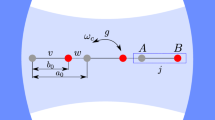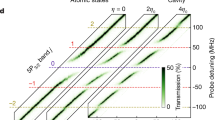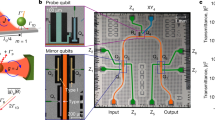Abstract
Atomically strong light pulses can drive sub-optical-cycle dynamics. When the Rabi frequency—the rate of energy exchange between light and matter—exceeds the optical carrier frequency, fascinating non-perturbative strong-field phenomena emerge, such as high-harmonic generation and lightwave transport. Here, we explore a related novel subcycle regime of ultimately strong light–matter interaction without a coherent driving field. We use the vacuum fluctuations of nanoantennas to drive cyclotron resonances of two-dimensional electron gases to vacuum Rabi frequencies exceeding the carrier frequency. Femtosecond photoactivation of a switch element inside the cavity disrupts this ‘deep-strong coupling’ more than an order of magnitude faster than the oscillation cycle of light. The abrupt modification of the vacuum ground state causes spectrally broadband polarization oscillations confirmed by our quantum model. In the future, this subcycle shaping of hybrid quantum states may trigger cavity-induced quantum chemistry, vacuum-modified transport or cavity-controlled superconductivity, opening new scenarios for non-adiabatic quantum optics.
This is a preview of subscription content, access via your institution
Access options
Access Nature and 54 other Nature Portfolio journals
Get Nature+, our best-value online-access subscription
$29.99 / 30 days
cancel any time
Subscribe to this journal
Receive 12 print issues and online access
$209.00 per year
only $17.42 per issue
Buy this article
- Purchase on Springer Link
- Instant access to full article PDF
Prices may be subject to local taxes which are calculated during checkout




Similar content being viewed by others
Data availability
The data that support the plots within this paper and other findings of this study are available from the corresponding authors upon reasonable request.
References
Corkum, P. B. & Krausz, F. Attosecond science. Nat. Phys. 3, 381–387 (2007).
Mücke, O. D., Tritschler, T., Wegener, M., Morgner, U. & Kärtner, F. X. Signatures of carrier-wave Rabi flopping in GaAs. Phys. Rev. Lett. 87, 057401 (2001).
Hohenleutner, M. et al. Real-time observation of interfering crystal electrons in high-harmonic generation. Nature 523, 572–575 (2015).
Langer, F. et al. Lightwave-driven quasiparticle collisions on a subcycle timescale. Nature 533, 225–229 (2016).
Garg, M. et al. Multi-petahertz electronic metrology. Nature 538, 359–363 (2016).
Schultze, M. et al. Attosecond band-gap dynamics in silicon. Science 346, 1348–1352 (2014).
Ludwig, M. et al. Sub-femtosecond electron transport in a nanoscale gap. Nat. Phys. 16, 341–345 (2020).
Kockum, A. F., Miranowicz, A., De Liberato, S., Savasta, S. & Nori, F. Ultrastrong coupling between light and matter. Nat. Rev. Phys. 1, 19–40 (2019).
Forn-Díaz, P., Lamata, L., Rico, E., Kono, J. & Solano, E. Ultrastrong coupling regimes of light-matter interaction. Rev. Mod. Phys. 91, 025005 (2019).
Li, X. et al. Vacuum Bloch–Siegert shift in Landau polaritons with ultra-high cooperativity. Nat. Photon. 12, 324–329 (2018).
Paravicini-Bagliani, G. L. et al. Magneto-transport controlled by Landau polariton states. Nat. Phys. 15, 186–190 (2019).
Orgiu, E. et al. Conductivity in organic semiconductors hybridized with the vacuum field. Nat. Mater. 14, 1123–1129 (2015).
Thomas, A. et al. Tilting a ground-state reactivity landscape by vibrational strong coupling. Science 363, 615–619 (2019).
Chikkaraddy, R. et al. Single-molecule strong coupling at room temperature in plasmonic nanocavities. Nature 535, 127–130 (2016).
Anappara, A. et al. Signatures of the ultrastrong light-matter coupling regime. Phys. Rev. B 79, 201303(R) (2009).
Günter, A. et al. Sub-cycle switch-on of ultrastrong light–matter interaction. Nature 458, 178–181 (2009).
Todorov, Y. et al. Ultrastrong light-matter coupling regime with polariton dots. Phys. Rev. Lett. 105, 196402 (2010).
Scalari, G. et al. Ultrastrong coupling of the cyclotron transition of a 2D electron gas to a THz metamaterial. Science 335, 1323–1326 (2012).
Bayer, A. et al. Terahertz light-matter interaction beyond unity coupling strength. Nano Lett. 17, 6340–6344 (2017).
Keller, J. et al. Few-electron ultrastrong light-matter coupling at 300 GHz with nanogap hybrid LC microcavities. Nano Lett. 17, 7410–7415 (2017).
Yoshihara, F. et al. Superconducting qubit–oscillator circuit beyond the ultrastrong-coupling regime. Nat. Phys. 13, 44–47 (2017).
De Liberato, S. Light-matter decoupling in the deep strong coupling regime: the breakdown of the Purcell effect. Phys. Rev. Lett. 112, 016401 (2014).
Ciuti, C., Bastard, G. & Carusotto, I. Quantum vacuum properties of the intersubband cavity polariton field. Phys. Rev. B 72, 115303 (2005).
Schlawin, F., Cavalleri, A. & Jaksch, D. Cavity-mediated electron-photon superconductivity. Phys. Rev. Lett. 122, 133602 (2019).
Thomas, A. et al. Exploring superconductivity under strong coupling with the vacuum electromagnetic field. Preprint at https://arxiv.org/abs/1911.01459v2 (2019).
De Liberato, S., Ciuti, C. & Carusotto, I. Quantum vacuum radiation spectra from a semiconductor microcavity with a time-modulated vacuum Rabi frequency. Phys. Rev. Lett. 98, 103602 (2007).
Wilson, C. M. et al. Observation of the dynamical Casimir effect in a superconducting circuit. Nature 479, 376–379 (2011).
Hawking, S. W. Black hole explosions? Nature 248, 30–31 (1974).
Chen, H.-T. et al. Experimental demonstration of frequency-agile terahertz metamaterials. Nat. Photon. 2, 295–298 (2008).
Bühler, J., Allerbeck, J., Fitzky, G., Brida, D. & Leitenstorfer, A. Terahertz shockwaves generated by a precise subcycle cut of the electric field. Optica 5, 821–824 (2018).
Riek, C. et al. Subcycle quantum electrodynamics. Nature 541, 376–379 (2017).
Benea-Chelmus, I. C., Settembrini, F. F., Scalari, G. & Faist, J. Electric field correlation measurements on the electromagnetic vacuum state. Nature 414, 286–289 (2001).
Hopfield, J. J. Theory of the contribution of excitons to the complex dielectric constant of crystals. Phys. Rev. 112, 1555–1567 (1958).
Kindt, J. T. & Schmuttenmaer, C. A. Theory for determination of the low-frequency time-dependent response function in liquids using time-resolved terahertz pulse spectroscopy. J. Chem. Phys. 110, 8589–8596 (1999).
Huber, R. et al. How many-particle interactions develop after ultrafast excitation of an electron–hole plasma. Nature 414, 286–289 (2001).
Acknowledgements
The work in Regensburg was supported by the Deutsche Forschungsgemeinschaft (DFG) through grant numbers LA 3307/1-2, BO 3140/3-2 and HU 1598/2 as well as by the European Research Council (ERC) under the European Union’s Horizon 2020 research and innovation programme by grant agreement number 305003, Ultrafast quantum physics on the sub-cycle time scale (QUANTUMsubCYCLE), and through Future and Emerging Technologies (FET) grant number 737017, Mid- and far-IR optoelectronic devices based on Bose-Einstein condensation (MIR-BOSE).
Author information
Authors and Affiliations
Contributions
C.L., M.H., V.Z., D.B. and R.H. designed and implemented the structures. M.H., J.M. and C.L. carried out the experiment with support from R.H. The theoretical modelling was carried out by C.L., M.H., J.M., R.H. and C.C. C.L., D.B. and R.H. supervised the study. All authors analysed the data, discussed the results and contributed to the writing of the manuscript.
Corresponding authors
Ethics declarations
Competing interests
The authors declare no competing interests.
Additional information
Publisher’s note Springer Nature remains neutral with regard to jurisdictional claims in published maps and institutional affiliations.
Extended data
Extended Data Fig. 1 Calculated spatial and spectral characteristics of the resonator structure.
a, Enhancement of the amplitude of the right-circularly polarized near-field component, 𝐸σ+, of the fundamental LC mode, relative to the far-field amplitude, E0, at a depth of z = -200 nm, for an undoped switching layer (see Fig. 1). b, Corresponding near-field enhancement of the dipolar mode. c, Near-field enhancement with a doped switching layer, for the LC mode, and d, for the dipolar mode. e, Transmission spectra for a doped and an undoped switching patch, respectively.
Extended Data Fig. 2 Experimental setup.
The near-infrared (NIR) pulse train (centre wavelength, 807 nm; pulse energy, 5.5 mJ, pulse duration, 33 fs) generated in a titanium-sapphire amplifier (repetition rate, 3 kHz) is split by a beam splitter (BS1) into a first branch driving an optical parametric amplifier (OPA) and a second branch for THz generation and detection. A delay stage (DS1) controls the common delay, tD, of THz and electro-optic sampling pulses. A second beam splitter (BS2) picks off the gate pulse which is delayed by a second stage (DS2) controlling the electro-optic sampling delay, t. The gate is focused through the detection crystal (C2) by a lens (L1), after which its polarisation state is analysed by corresponding optics (λ/4, quarter wave plate; WP, Wollaston prism; PD, photodiodes). The NIR power transmitted through BS2 is focused onto the THz generation crystal (C1) by an off-axis parabolic mirror. A wafer (W) transmits only the generated THz waveform. Off- axis parabolic mirrors recollimate and focus the pulses through the sample (S), which is located in the magnet cryostat (MC) and kept at a temperature of 10 K. Here, a magnetic bias (B) of up to 5.5 T is applied perpendicular to the sample surface. The transmitted THz waveform is recollimated and focused onto the detector crystal, collinearly with the gate pulse. The NIR signal output from the OPA (centre wavelength, 1200 nm; pulse energy, 17 µJ, pulse duration, 70 fs) is focused by a lens (L2) onto the focal point of the THz pulses on the sample. Mechanical choppers (CH) are placed in the beam paths of THz generation and switching pulses to enable differential detection.
Extended Data Fig. 3 Subcycle switching dynamics of the 6-QW structure with ΩR/ωLC = 1.3.
a, Enhancement of the right-circularly polarized near-field amplitude, 𝐸σ+, of the fundamental LC mode relative to the far-field amplitude, E0, at a depth of z = −200 nm, for an unexcited switching layer. b, Corresponding near-field enhancement with a photoexcited switching layer. c, Transmission spectra of the 6-QW structure as a function of pump-probe delay time, τ, at the anti-crossing point. The dashed lines mark the frequency windows of the lower and upper polariton resonances at 0.17 THz and 1.62 THz, respectively. The transmission exhibits oscillatory dynamics at the frequency of d, the UP, and e, the LP, caused by the non-adiabatic switch-off. f, Spectrum of the switching dynamics of the LP of panel e. Vertical dashed lines indicate the resonance frequency of the LP, νLP, and 10 × νLP, for reference.
Extended Data Fig. 4 Switching dynamics of an uncoupled THz resonator.
a, Pump-probe THz signal during femtosecond photoexcitation. The charge carrier concentration resulting from femtosecond photoexcitation is 3.5 × 1018 cm−3. b, Corresponding transmission spectra, in the τ-frame. c, Black curve: Differential transmission of the LC mode extracted within the frequency window outlined in panel b by dashed black lines. Red curve: Differential transmission extracted within the frequency window outlined in panel b by dashed white lines, for reference.
Supplementary information
Supplementary Information
Supplementary Figs. 1–6 and discussion.
Rights and permissions
About this article
Cite this article
Halbhuber, M., Mornhinweg, J., Zeller, V. et al. Non-adiabatic stripping of a cavity field from electrons in the deep-strong coupling regime. Nat. Photonics 14, 675–679 (2020). https://doi.org/10.1038/s41566-020-0673-2
Received:
Accepted:
Published:
Issue Date:
DOI: https://doi.org/10.1038/s41566-020-0673-2
This article is cited by
-
Mode-multiplexing deep-strong light-matter coupling
Nature Communications (2024)
-
Temporal loss boundary engineered photonic cavity
Nature Communications (2021)



